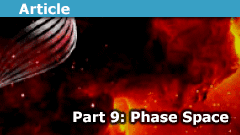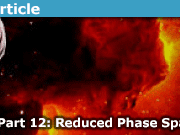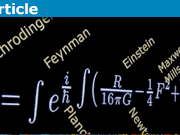Learn Phase Space in Mathematical Quantum Field Theory
The following is one chapter of a series on Mathematical Quantum Field Theory.
The previous chapter is 7. Observables.
The next chapter is 9. Propagators.
8. Phase space
It might seem that with the construction of the local observables (def. 7.36) on the on-shell space of field histories (prop. 5.10) the field theory defined by a Lagrangian density (def. 5.1) has been completely analyzed: This data specifies, in principle, which field histories are realized, and which observable properties these have.
In particular, if the Euler-Lagrange equations of motion (def. 5.22) admit Cauchy surfaces (def. 8.1 below), i.e. spatial codimension 1 slices of spacetimes such that a field history is uniquely specified already by its restriction to the infinitesimal neighbourhood of that spatial slice, then a sufficiently complete collection of local observables whose spacetime support (def. 7.29) covers that Cauchy surface allows to predict the evolution of the field histories through time from that Cauchy surface.
This is all what one might think a theory of physical fields should accomplish, and in fact this is essentially all that was thought to be required of a theory of nature from about Isaac Newton’s time to about Max Planck’s time.
But we have seen that a remarkable aspect of Lagrangian field theory is that the de Rham differential of the local Lagrangian density ##\mathbf{L}## (def. 5.1) decomposes into two kinds of variational differential forms (prop. 5.10), one of which is the Euler-Lagrange form which determines the equations of motion (48).
However, there is a second contribution: The presymplectic current ##\Omega_{BFV} \in \Omega^{p,2}_{\Sigma}(E)## (53). Since this is of horizontal degree ##p##, its transgression (def. 7.30) implies a further structure on the space of field histories restricted to spacetime submanifolds of dimension ##p## (i.e. of spacetime “codimension 1”). There may be such submanifolds such that this restriction to their infinitesimal neighbourhood (example 3.30) does not actually change the on-shell space of field histories, these are called the Cauchy surfaces (def. 8.1 below).
By the Hamiltonian Noether theorem (prop. 6.20) the presymplectic current induces infinitesimal symmetries acting on field histories and local observables, given by the local Poisson bracket (prop. 6.21). The transgression (def. 7.30) of the presymplectic current to these Cauchy surfaces yields the corresponding infinitesimal symmetry group acting on the on-shell field histories, whose Lie bracket is the Poisson bracket pairing on on-shell observables (example 8.3 below). This data, the on-shell space of field histories on the infinitesimal neighbourhood of a Cauchy surface equipped with infinitesimal symmetry exhibited by the Poisson bracket is called the phase space of the theory (def. 8.2) below.
In fact if enough Cauchy surfaces exist, then the presymplectic forms associated with any one choice turn out do agree after pullback to the full on-shell space of field histories, exhibiting this as the covariant phase space of the theory (prop. 8.6 below) which is hence manifestly independent of aa choice of space/time splitting. Accordingly, also the Poisson bracket on on-shell observables exists in a covariant form; for free field theories with Green hyperbolic equations of motion (def. 7.17) this is called the Peierls-Poisson bracket (theorem 8.7 below). The integral kernel for this Peierls-Poisson bracket is called the causal propagator (prop. 7.22). Its “normal ordered” or “positivefrequency component”, called the Hadamard propagator (def. 9.52 below) as well as the corresponding time-ordered variant, called the Feynman propagator (def. 9.55 below), which we discuss in detail in Propagators below, control the causal perturbation theory for constructing perturbative quantum field theory by deforming the commutative pointwise product of on-shell observables to a non-commutative product governed to first order by the Peierls-Poisson bracket.
To see how such a deformation quantization comes about conceptually from thephase space strucure, notice from the basic principles of homotopy theory that given any structure on a space which is invariant with respect to a symmetry group> acting on the space (here: the presymplectic current) then the true structure at hand is the homotopy quotient of that space by that symmetry group>. We will explain this further below. This here just to point out that the homotopy quotient of the phase space by the infinitesimal symmetries of the presymplectic current is called the symplectic groupoid and that the true algebra of observables is hence the (polarized) convolution algebra of functions on this groupoid. This turns out to the “algebra of quantum observables” and the passage from the naive local observables on presymplectic phase space to this non-commutative algebra of functions on its homotopy quotient to the symplectic groupoid is called quantization. This we discuss in much detail below; for the moment this is just to motivate why the covariant phase space is the crucial construction to be extracted from a Lagrangian field theory.
$$
\array{
\left\{
\array{
\text{on-shell space}
\\
\text{ of field histories}
\\
\text{restricted to}
\\
\text{Cauchy surface}
}
\right\}
&\overset{\array{ \text{homotopy} \\ \text{quotient} \\ \text{by} \\ \text{infinitesimal} \\ \text{symmetries} }}{\longrightarrow}
&
\left\{
\array{
\text{covariant}
\\
\text{phase space}
}
\right\}
&\overset{ \array{\text{Lie algebra} \\ \text{of functions} } }{\longrightarrow}&
\left\{
\array{
\text{Poisson algebra}
\\
\text{of observables}
}
\right\}
\\
&
\searrow
&
\Big\downarrow{}^\rlap{{\text{Lie integration}}}
&&
{}^{\llap{quantization}}\Big\downarrow
\\
&& \left\{
\array{
\text{symplectic}
\\
\text{groupoid}
}
\right\}
&
\overset{
\array{
\text{polarized}
\\
\text{convolution}
\\
\text{algebra}
}
}{\longrightarrow}&
\left\{
\array{
\text{quantum algebra}
\\
\text{of observables}
}
\right\}
}
$$
We now discuss these topics:
Covariant phase space
Definition 8.1. (Cauchy surface)
Given a Lagrangian field theory ##(E, \mathbf{L})## on a spacetime ##\Sigma## (def. 5.1), then a Cauchy surface is a submanifold ##\Sigma_p \rightarrow \Sigma## (def. 3.34) such that the restriction map from the on-shell space of field histories ##\Gamma_\Sigma(E)_{\delta_{EL}\mathbf{L} = 0}## (65) to the space ##\Gamma_{\Sigma_p}(E)_{\delta_{EL}\mathbf{L} = 0}## (66) of on-shell field histories restricted to the infinitesimal neighbourhood of ##\Sigma_p## (example 3.30) is an isomorphism:
| $$ \label{CauchySurfaceIsomorphismOnHistorySpace} \Gamma_\Sigma(E)_{\delta_{EL} \mathbf{L} = 0 } \underset{\simeq}{\overset{(-)\vert_{N_\Sigma \Sigma_p}}{\longrightarrow}} \Gamma_{\Sigma_p}(E)_{\delta_{EL}\mathbf{L} = 0} \,. $$ | (108) |
Definition 8.2. (phase space associated with a Cauchy surface)
Given a Lagrangian field theory ##(E, \mathbf{L})## on a spacetime ##\Sigma## (def. 5.1) and given a Cauchy surface ##\Sigma_p \rightarrow \Sigma## (def. 8.1) then the corresponding phase space is
- the super smooth set ##\Gamma_{\Sigma_p}(E)_{\delta_{EL}\mathbf{L} = 0}## (66) of on-shell field histories restricted to the infinitesimal neighbourhood of ##\Sigma_p##;
- equipped with the differential 2-form (as in def. 3.18)
$$
\label{TransgressionOfPresymplecticCurrentToCauchySurface}
\omega_{\Sigma_p}
\;:=\;
\tau_{\Sigma_p}\left(\Omega_{BFV}\right)
\;\in\;
\Omega^2\left(
\Gamma_{\Sigma_p}(E)_{\delta_{EL}\mathbf{L} = 0}
\right)
$$(109) which is the distributional transgression (def. 7.30) of the presymplectic current ##\Omega_{BFV}## (def. 5.10) to ##\Sigma_p##.
This ##\omega_{\Sigma_p}## is a closed differential form in the sense of def. 3.18, due to prop. 7.33
and using that ##\Omega_{BFV} = \delta \Theta_{BFV}## is closed by definition (53). As such this is called the presymplectic form on the phase space.
Example 8.3. (evaluation of transgressed variational form on tangent vectors for free field theory)
Let ##(E,\mathbf{L})## be a Lagrangian field theory (def. 5.1) which is free (def. 5.23) hence whose field bundle is a some smooth super vector bundle (example 3.4) and whose Euler-Lagrange equation of motion is linear. Then the synthetic tangent bundle (def. 3.29) of the on-shell space of field histories ##\Gamma_{\Sigma}(E)_{\delta_{EL}\mathbf{L} = 0}## (65) with spacelike compact support (def 2.36) is canonically identified with the Cartesian product of this super smooth set with itself
$$
T\left(
\Gamma_{\Sigma,scp}(E)_{\delta_{EL} \mathbf{L} = 0}
\right)
\;\simeq\;
\left(\Gamma_{\Sigma,scp}(E)_{\delta_{EL} \mathbf{L} = 0}\right)
\times
\left(\Gamma_{\Sigma,scp}(E)_{\delta_{EL} \mathbf{L} = 0}\right)
\,.
$$
With field coordinates as in example 3.4, we may expand the presymplectic current as
$$
\Omega_{BFV}
=
\left(\Omega_{BFV}\right)^{\mu_1, \cdots, \mu_{k_1}, \nu_1, \cdots, \nu_{k_2}, \kappa}_{a_1 a_2}
\delta \phi^{a_1}_{\mu_1 \cdots \mu_k} \wedge \delta \phi^{a_2}_{\nu_1 \cdots \nu_{k_2}}
\wedge
\iota_{\partial_\kappa} dvol_\Sigma
\,,
$$
where the components ##(\Omega_{BFV})_{a_1 a_2}^{\mu_1, \cdots, \mu_{k_1}, \nu_1, \cdots, \nu_{k_2}, \kappa}## are smooth functions on the jet bundle.
Under these identifications the value of the presymplectic form ##\omega_{\Sigma_p}## (109) on two tangent vectors ##\vec \Phi_1, \vec \Phi_2 \in \Gamma_{\Sigma,scp}(E)## at a point ##\Phi_1, \Phi_2 \in \Gamma_{\Sigma,scp}(E)## is
$$
\omega_{\Sigma_p}(\vec \Phi_1, \vec \Phi_2)
\;=\;
\underset{\Sigma_p}{\int}
\left(\Omega_{BFV}\right)^{\mu_1, \cdots, \mu_{k_1}, \nu_1, \cdots, \nu_{k_2}, \kappa}_{a_1 a_2}(\Phi_1(x), \Phi_2(x))
\left(
\frac{\partial}{\partial x^{\mu_1}}
\cdots
\frac{\partial}{\partial x^{\mu_{k_1}}}
\vec \Phi_1(x)
\right)
\left(
\frac{\partial}{\partial x^{\nu_1}}
\cdots
\frac{\partial}{\partial x^{\nu_{k_2}}}
\vec \Phi_2(x)
\right)
\,
\iota_{\partial_\kappa} dvol_\Sigma(x)
\,.
$$
Example 8.4. (presymplectic form for free real scalar field)
Consider the Lagrangian field theory for the free real scalar field from example 5.4.
Under the identification of example 8.3 the presymplectic form on thephase space (def. 8.2) associated with a Cauchy surface ##\Sigma_p \rightarrow \Sigma## is given by
$$
\begin{aligned}
\omega_{\Sigma_p}(\vec \Phi_1, \vec\Phi_2)
& =
\int_{\Sigma_{p}}
\left(
\frac{\partial \vec \Phi_1}{\partial x^\mu}(x) \vec \Phi_2(x)
–
\vec \Phi_1(x) \frac{\partial \vec \Phi_2}{\partial x^\mu}(x)
\right)
\eta^{\mu \nu}
\iota_{\partial_\mu} dvol_{\Sigma_{p}}(x)
\\
& =
\underset{\Sigma_p}{\int} K(\vec \Phi_1, \vec \Phi_2)
\,.
\end{aligned}
$$
Here the first equation follows via example 8.3 from the form of ##\Omega_{BFV}## from example 5.15, while the second equation identifies the integrand as the witness ##K## for the formally self-adjointness of the Klein-Gordon equation from example 5.26.
Example 8.5. (presymplectic form for free Dirac field)
Consider the Lagrangian field theory of the free Dirac field (example 5.8).
Under the identification of example 8.3 the presymplectic form on thephase space (def. 8.2) associated with a Cauchy surface ##\Sigma_p \rightarrow \Sigma## is given by
$$
\begin{aligned}
\omega_{\Sigma_p}(\theta_1 \vec \Psi_1, \theta_2 \vec\Psi_2)
& =
\int_{\Sigma_{p}}
\left(
\overline{\theta_1 \vec \psi_1}\gamma^\mu \left( \theta_2 \vec \Psi_2 \right)
\right)
\iota_{\partial_\mu} dvol_{\Sigma_{p}}(x)
\\
& =
\underset{\Sigma_p}{\int} K(\vec \Phi_1, \vec \Phi_2)
\,.
\end{aligned}
$$
Here the first equation follows via example 8.3 from the form of ##\Omega_{BFV}## from example 5.19, while the second equation identifies the integrand as the witness ##K## for the formally self-adjointness of the Dirac equation from example 5.30.
Proposition 8.6. (covariant phase space)
Consider ##(E, \mathbf{L})## a Lagrangian field theory on a spacetime ##\Sigma## (def. 5.1).
Let
$$
\Sigma_{tra} \overset{tra}{\rightarrow} \Sigma
$$
be a submanifold with two boundary components ##\partial \Sigma_{tra} = \Sigma_{in} \sqcup \Sigma_{out}## , both of which are Cauchy surfaces (def. 8.1).
Then the corresponding inclusion diagram
$$
\array{
&& \Sigma_{tra}
\\
& {}^{\llap{in}}\nearrow && \nwarrow^{\mathrm{out}}
\\
\Sigma_{in}
&& &&
\Sigma_{out}
}
$$
induces a Lagrangian correspondence between the associated phase spaces (def. 8.2)
$$
\array{
&& \Gamma_{\Sigma_{tra}}(E)_{\delta_{EL} \mathbf{L} = 0}
\\
& {}^{\llap{ (-)\vert_{in} }}\swarrow && \searrow^{\rlap{ (-)\vert_{out} }}
\\
\Gamma_{\Sigma^{(in)}}(E)_{\delta_{EL}\mathbf{L}= 0}
&& &&
\Gamma_{\Sigma^{(out)}}(E)_{\delta_{EL}\mathbf{L}= 0}
\\
& {}_{\llap{\omega_{in}}}\searrow && \swarrow_{\rlap{\omega_{out}}}
\\
&& \mathbf{\Omega}^{2}
}
$$
in that the pullback of the two presymplectic forms (109) coincides on the space of field histories:
$$
\left( (-)\vert_{in}\right)^\ast\left( \omega_{in}\right)
\;=\;
\left( (-)\vert_{out} \right)^\ast \left( \omega_{out} \right)
\phantom{AAAA}
\in
\Omega^2
\left(
\Gamma_{\Sigma_{tra}}(E)_{\delta_{EL} \mathbf{L} = 0}
\right)
\,.
$$
Hence there is a well defined presymplectic form
$$
\omega \in \Omega^2\left( \Gamma_\Sigma(E)_{\delta_{EL}\mathbf{L}} = 0 \right)
$$
on the genuine space of field histories, given by ##\omega := i^\ast \omega_{\Sigma_p}## for any Cauchy surface ##\Sigma_p \overset{i}{\rightarrow} \Sigma##. This presymplectic smooth space
$$
\left(
\Gamma_\Sigma(E)_{\delta_{EL}\mathbf{L}}
\,,\,
\omega
\right)
$$
is therefore called the covariant phase space of the Lagrangian field theory ##(E,\mathbf{L})##.
Proof. By prop. (56) the total spacetime derivative ##d \Omega_{BFV}## of the presymplectic current vanishes on-shell:
$$
d \Omega_{BFV} = – \delta \delta_{EL} \mathbf{L}
$$
in that the pullback (def. 1.17) along the shell inclusion ##\mathcal{E} \overset{i_{\mathcal{E}}}{\rightarrow} J^\infty_\Sigma(E)## (49) vanishes:
$$
\begin{aligned}
(i_{\mathcal{E}})^\ast
\left(
d \Omega_{BFV}
\right)
& =
– (i_{\mathcal{E}})^\ast
\left(
\delta \delta_{EL} \mathcal{L}
\right)
\\
& =
– \delta
\underset{
= 0
}{
\underbrace{
(i_{\mathcal{E}})^\ast
\left(
\delta_{EL} \mathbf{L}
\right)
}
}
\\
& = 0
\end{aligned}
$$
This implies that the transgression of ##d \Omega_{BFV}## to the on-shell space of field histories ##\Gamma_{\Sigma_{tra}}(E)_{\delta_{EL}\mathbf{L} = 0}## vanishes (since by definition (63) that involves pulling back through the shell inclusion)
$$
\tau_{\Sigma_{tra}}(d \Omega_{BFV}) = 0
\,.
$$
But then the claim follows with prop. 7.33:
$$
\begin{aligned}
0
& = \tau_{\Sigma_{tra}}(d \Omega_{BFV})
\\
& = ((-)\vert_{\Sigma_{tra}})^\ast \tau_{\partial \Sigma_{tra}} \Omega_{BFV}
\,.
\end{aligned}
$$
Theorem 8.7. (polynomial Poisson bracket on covariant phase space — the Peierls bracket)
Let ##(E,\mathbf{L})## be a Lagrangian field theory (def. 5.1) such that
- it is a free field theory (def. 5.23)
- whose Euler-Lagrange equation of motion ##P \Phi = 0## (def. 5.22) is
Write
$$
\mathrm{G}_P
\;\colon\;
LinObs(E_{scp},\mathbf{L})^{reg}
\overset{\mathrm{G}_P}{\longrightarrow}
\Gamma_{\Sigma,scp}(E)_{\delta_{EL}\mathbf{L} = 0}
$$
for the linear map from regular linear field observables (def. 7.28) to on-shell field histories with spatially compact support (def. 2.36) given under the identification (99) by the causal Green function ##\mathrm{G}_P## (def. 7.16).
Then for every Cauchy surface ##\Sigma_p \rightarrow \Sigma## (def. 8.1) this map is an inverse to the presymplectic form ##\omega_{\Sigma_p}## (def. 8.2) in that, under the identification of tangent vectors to field histories from example 8.3, we have that the composite
| $$ \label{ForGreenHyperbolicFreeFieldTheoryCausalGreenFunctionIsInverseToPresymplecticFormOnRegularLinearObservables} \array{ \omega_{\Sigma_p}(\mathrm{G}_P(-),(-)) \;=\; ev &\colon& LinObs(E_{scp},\mathbf{L})^{reg} &\otimes& \Gamma_{\Sigma,scp}(E) &\longrightarrow& \mathbb{C} \\ && (A &,& \Phi) &\mapsto& A(\Phi) } $$ | (110) |
equals the evaluation map of observables on field histories.
This means that for every Cauchy surface ##\Sigma_p## the presymplectic form ##\omega_{\Sigma_p}## restricts to a symplectic form on regular linear observables. The corresponding Poisson bracket is
$$
\left\{
-,-
\right\}_{\Sigma_p}
\;:=\;
\omega_{\Sigma_p}(\mathrm{G}_P(-), \mathrm{G}_P(-))
\;\;\colon\;\;
LinObs(E_{scp},\mathbf{L})^{reg} \otimes LinObs(E_{scp},\mathbf{L})^{reg}
\longrightarrow
\mathbb{R}
\,.
$$
Moreover, equation (110) implies that this is the covariant Poisson bracket in the sense of the covariant phase space (def. 8.6) in that it does not actually depend on the choice of Cauchy surface.
An equivalent expression for the Poisson bracket that makes its independence from the choice of Cauchy surface manifest is the ##P##-Peierls bracket given by
| $$ \label{ThePPeierlsBracket} \array{ LinObs(E_{scp},\mathbf{L})^{reg} \otimes LinObs(E_{scp},\mathbf{L})^{reg} &\overset{\{-,-\}}{\longrightarrow}& \mathbb{R} \\ (\alpha^\ast, \beta^\ast) &\mapsto& \underset{\Sigma}{\int} \mathrm{G}(\alpha^\ast) \cdot \beta^\ast \, dvol_\Sigma } $$ | (111) |
where on the left ##\alpha^\ast, \beta^\ast \in \Gamma_{\Sigma,cp}(E^\ast) \simeq LinObs(E_{scp},\mathbf{L})^{reg}##
Hence under the given assumptions, for every Cauchy surface the Poisson bracket associated with that Cauchy surface equals the invariantly (“covariantly”) defined Peierls bracket
$$
\{-,-\}_{\Sigma_p} = \{-,-\}
\,.
$$
Finally this means that in terms of the causal propagator ##\Delta## (90) the covariant Peierls-Poisson bracket is given in generalized function-notation by
| $$ \label{CausalPropagatorPPeierlsBracket} \{\alpha^\ast, \beta^\ast\} \;=\; \underset{\Sigma}{\int} \underset{\Sigma}{\int} \alpha^\ast(x) \cdot \Delta(x,y) \cdot \beta^\ast(y) \, dvol_\Sigma(x)\, dvol_\Sigma(y) $$ | (112) |
Therefore, while the point-evaluation field observables ##\mathbf{\Phi}^a(x)## (def. 7.2) are not themselves regular observables (def. 7.28), the Peierls-Poisson bracket (112) is induced from the following distributional bracket between them
$$
\left\{
\mathbf{\Phi}^a(x)
,
\mathbf{\Phi}^b(y)
\right\}
\;=\;
\Delta^{a b}(x,y)
$$
with the causal propagator (90) on the right, in that with the identification (100) the Peierls-Poisson bracket on regular linear observables arises as follows:
$$
\begin{aligned}
\left\{
\underset{\Sigma}{\int} \alpha^\ast_a(x) \mathbf{\Phi}^a(x) \, dvol_\Sigma(x)
\,,\,
\underset{\Sigma}{\int} \beta^\ast_b(y) \mathbf{\Phi}^b(y) \, dvol_\Sigma(y)
\right\}
& =
\underset{\Sigma}{\int} \underset{\Sigma}{\int}
\alpha^\ast_a(x)
\underset{= \Delta^{a b}(x,y)}{
\underbrace{
\left\{
\mathbf{\Phi}^a(x),
\mathbf{\Phi}^b(y)
\right\}
}
}
\beta^\ast_b(y)
\, dvol_\Sigma(x)\, dvol_\Sigma(y)
\\
& =
\underset{\Sigma}{\int} \underset{\Sigma}{\int}
\alpha^\ast_a(x)
\Delta^{a b}(x,y)
\beta^\ast_b(y)
\, dvol_\Sigma(x)\, dvol_\Sigma(y)
\end{aligned}
$$
(Khavkine 14, lemma 2.5)
Proof. Consider two more Cauchy surfaces ##\Sigma_p^\pm \rightarrow I^\pm(\Sigma) \rightarrow \Sigma##, in the future ##I^+## and in the past ##I^-## of ##\Sigma##, respectively. Choose a partition of unity on ##\Sigma## consisting of two elements ##\chi^\pm \in C^\infty(\Sigma)## with support bounded by these Cauchy surfaces: ##supp(\chi_\pm) \subset I^\pm(\Sigma^{\mp})##.
Then define
| $$ \label{SplittingOfGreenExactSequenceType} P_\chi \;\colon\; \Gamma_{\Sigma,scp}(E) \longrightarrow \Gamma_{\Sigma,cp}(E^\ast) $$ | (113) |
by
| $$ \label{SplittingOfGreenExactSequence} \begin{aligned} P_\chi(\Phi) & := \phantom{-} P(\chi_+ \Phi) \\ & = – P(\chi_- \Phi) \,. \end{aligned} $$ | (114) |
Notice that the support of the partitioned field history is in the compactly sourced future/past cone
| $$ \label{ChipmPhiIsSupportedInPastFuture} \chi_\pm \Phi \;\in\; \Gamma_{\Sigma,\pm cp}(E) $$ | (115) |
since ##\Phi## is supported in the compactly sourced causal cone, but that ##P(\chi_\pm \Phi)## indeed has compact support as required by (113): Since ##P(\Phi) = 0##, by assumption, the support is the intersection of that of ##\Phi## with that of ##d \chi_\pm##, and the first is spacelike compact by assumption, while the latter is timelike compact, by definition of partition of unity.
Similarly, the equality in (114) holds because by partition of unity ##P(\chi_+ \Phi) + P(\chi_-\Phi) = P((\chi_+ + \chi_-)\Phi ) = P(\Phi) = 0##.
It follows that
| $$ \label{PchiIsRightInverseToGP} \begin{aligned} \mathrm{G}_P \circ P_\chi (\Phi) & = \left( \mathrm{G}_{P,+} – \mathrm{G}_{P,-} \right) P_\chi (\Phi) \\ & = \underset{ = \chi_+ \Phi}{\underbrace{\mathrm{G}_{P,+} P(\chi_+ \Phi)}} + \underset{ = \chi_- \Phi }{\underbrace{\mathrm{G}_{P,-} P(\chi_- \Phi)}} \\ & = (\chi_+ + \chi_-)\Phi \\ & = \Phi \,, \end{aligned} $$ | (116) |
where in the second line we chose from the two equivalent expressions (114) such that via (115) the defining property of the advanced or retarded Green function, respectively, may be applied, as shown under the braces.
(Khavkine 14, lemma 2.1)
Now we apply this to the computation of ##\omega_{\Sigma_p}(\mathrm{G}_P(-),-)##:
$$
\begin{aligned}
\omega_{\Sigma_P}(\mathrm{G}_P(\alpha^\ast),\vec \Phi)
& =
\underset{\Sigma_P}{\int} K(\mathrm{G}_P(\alpha^\ast), \vec \Phi)
\\
& =
\underset{\Sigma_P}{\int} K(\mathrm{G}_P(\alpha^\ast), \chi_+\vec \Phi)
+
\underset{\Sigma_P}{\int} K(\mathrm{G}_P(\alpha^\ast), \chi_-\vec \Phi)
\\
& =
\underset{I^-(\Sigma_P)}{\int} d K(\mathrm{G}_P(\alpha^\ast), \chi_+\vec \Phi)
–
\underset{I^+(\Sigma_P)}{\int} d K(\mathrm{G}_P(\alpha^\ast), \chi_-\vec \Phi)
\\
& =
\underset{I^-(\Sigma_P)}{\int}
\left(
\underset{= 0}{
\underbrace{
P(\mathrm{G}_P(\alpha^\ast))}} \cdot \chi_+\vec \Phi
\mp
\mathrm{G}_P(\alpha^\ast) \cdot P(\chi_+ \vec \Phi)
\right)
dvol_\Sigma
–
\underset{I^+(\Sigma_P)}{\int}
\left(
\underset{= 0}{
\underbrace{
P(\mathrm{G}_P(\alpha^\ast))}} \cdot \chi_-\vec \Phi
\mp
\mathrm{G}_P(\alpha^\ast) \cdot P(\chi_- \vec \Phi)
\right)
dvol_\Sigma
\\
& =
\mp
\left(
\underset{I^-(\Sigma_P)}{\int}
\mathrm{G}_P(\alpha^\ast) \cdot P(\chi_+ \vec \Phi)
dvol_\Sigma
+
\underset{I^+(\Sigma_P)}{\int}
\mathrm{G}_P(\alpha^\ast) \cdot P(\chi_+ \vec \Phi)
dvol_\Sigma
\right)
\\
& =
\underset{\Sigma}{\int} \mathrm{G}_P(\alpha^\ast) \cdot P(\chi_+ \vec \Phi) dvol_\Sigma
\\
& =
\underset{\Sigma}{\int} \alpha^\ast \cdot \mathrm{G}_{P} (P (\chi_+ \vec \Phi))
\\
& =
\underset{\Sigma}{\int} \alpha^\ast \cdot \vec \Phi
\end{aligned}
$$
Here we computed as follows:
- applied the assumption that ##\omega_{\Sigma_p}(-,-) = \underset{\Sigma_p}{\int} K(-,-)##;
- applied the above partition of unity;
- used the Stokes theorem (prop. 1.25) for the past and the future of ##\Sigma_p##, respectively;
- applied the definition of ##d K## as the witness of the formal (anti-) self-adjointness of ##P## (def. 4.9);
- used ##P\circ \mathrm{G}_p = 0## on ##\Gamma_{\Sigma,cp}(E^\ast)## (def. 7.16) and used (114);
- unified the two integration domains, now that the integrands are the same;
- used the formally (anti-)self adjointness of the Green functions (example 7.20);
- used (116).
Example 8.8. (scalar field and Dirac field have covariant Peierls-Poisson bracket)
Examples of free Lagrangian field theories for which the assumptions of theorem 8.7 are satisfied, so that the covariant Poisson bracket exists in the form of the Peierls bracket include
For the free scalar field this is the statement of example 7.18
with example 8.4, while for the Dirac field this is the statement of example 7.19 with example 8.5.
For the free electromagnetic field (example 5.5) the assumptions of theorem 8.7 are violated, the covariant phase space does not exist. But in the discussion of Gauge fixing, below, we will find that for an equivalent re-incarnation of the electromagnetic field, they are met after all.
BV-resolution of the covariant phase space
So far we have discussed the covariant phase space (prop. 8.6) in terms of explicit restriction to the shell. We now turn to the more flexible perspective where a homological resolution of the shell in terms of “antifields” is used (def. 7.40).
Example 8.9. (BV-presymplectic current)
Let ##(E,\mathbf{L})## be a Lagrangian field theory (def. 5.1) whose field bundle ##E## is a trivial vector bundle (example 3.4) and whose Lagrangian density ##\mathbf{L}## is spacetime-independent (example 5.12). Let ##\Sigma \times \{\varphi\} \rightarrow \mathcal{E}## be a constant section of the shell (57).
Then in the BV-variational bicomplex (107) there exists the BV-presymplectic potential
| $$ \label{BVPresymplecticPotential} \Theta_{BV} \;:=\; \phi^{\ddagger}_a \delta \phi^a \, dvol_\Sigma \;\in\; \Omega^{p,1}_\Sigma(E,\varphi)\vert_{\mathcal{E}_{BV}} $$ | (117) |
and the corresponding BV-presymplectic current
$$
\Omega_{BV}
;\in\;
\Omega^{p,2}_\Sigma(E,\varphi)\vert_{\mathcal{E}_{BV}}
$$
defined by
$$
\begin{aligned}
\Omega_{BV}
& :=
\delta \Theta_{BV}
\\
& =
\delta \phi^{\ddagger}_a \wedge \delta \phi^a \wedge dvol_{\Sigma}
\end{aligned}
\,,
$$
where ##(\phi^a)## are the given field coordinates, ##\phi^{\ddagger}_a## the corresponding antifield coordinates (105) and ##\frac{\delta_{EL} \mathbf{L}}{\delta \phi^a}## the corresponding components of the Euler-Lagrange form (prop. 5.10).
Proposition 8.10. (local BV-BFV relation)
Let ##(E,\mathbf{L})## be a Lagrangian field theory (def. 5.1) whose field bundle ##E## is a trivial vector bundle (example 3.4) and whose Lagrangian density ##\mathbf{L}## is spacetime-independent (example 5.12). Let ##\Sigma \times \{\varphi\} \rightarrow \mathcal{E}## be a constant section of the shell (57).
Then the BV-presymplectic current ##\Omega_{BV}## (def. 8.9) witnesses the on-shell vanishing (prop. (56)) of the total spacetime derivative of the genuine presymplectic current ##\Omega_{BFV}## (prop. 5.10) in that the total spacetime derivative of ##\Omega_{BFV}## equals the BV-differential ##s_{BV}## of ##\Omega_{BV}##:
$$
d \Omega_{BFV} = s \Omega_{BV}
\,.
$$
Hence if ##\Sigma_{tra} \rightarrow \Sigma## is a submanifold of spacetime of full dimension ##p+1## with boundary ##\partial \Sigma_{tra} = \Sigma_{in} \sqcup \Sigma_{out}##
$$
\array{
&& \Sigma_{tra}
\\
& {}^{\llap{in}}\nearrow && \nwarrow^{\mathrm{out}}
\\
\Sigma_{in}
&& &&
\Sigma_{out}
}
$$
then the pullback of the two presymplectic forms (109) on the incoming and outgoing spaces of field histories, respectively, differ by the BV-differential of the transgression of the BV-presymplectic current:
$$
\left( (-)\vert_{in}\right)^\ast\left( \omega_{in}\right)
\;-\;
\left( (-)\vert_{out} \right)^\ast \left( \omega_{out} \right)
=
\tau_{\mathbb{D} \times \Sigma_{tra}} ( s \Omega_{BV} )
\phantom{AAAA}
\in
\Omega^2
\left(
\Gamma_{\Sigma_{tra}}(E)_{\delta_{EL} \mathbf{L} = 0}
\right)
\,.
$$
This homological resolution of the Lagrangian correspondence that exhibits the “covariance” of the covariant phase space (prop. 8.6) is known as the BV-BFV relation (Cattaneo-Mnev-Reshetikhin 12 (9)).
Proof. For the first statement we compute as follows:
$$
\begin{aligned}
s \Omega_{BV}
& =
– \delta (s \phi^{\ddagger}_a) \delta \phi^a \wedge dvol_{\Sigma}
\\
& =
– \delta \frac{\delta_{EL}L }{\delta \phi^a} \delta \phi^a dvol_{\Sigma}
\\
& =
– \delta \delta_{EL}\mathbf{L}
\\
& =
d \Omega_{BFV}
\,,
\end{aligned}
$$
where the first steps simply unwind the definitions, and where the last step is prop. (56).
With this the second statement follows by immediate generalization of the proof of prop. 8.6.
Example 8.11. (derived presymplectic current of real scalar field)
Consider a Lagrangian field theory (def. 5.1) without any non-trivial implicit infinitesimal gauge transformations (def. link ); for instance the real scalar field from example 5.4.
Inside its local BV-complex (def. 7.40) we may form the linear combination of
- the presymplectic current ##\Omega_{BFV}## (example 5.15)
- the BF-presymplectic current ##\Omega_{BV}## (example 8.9).
This yields a vertical 2-form
$$
\Omega \;:=\; \Omega_{BV} + \Omega_{BFV} \;\; \in \Omega^{p,2}_\Sigma(E)\vert_{\mathcal{E}_{BV}}
$$
which might be called the derived presymplectic current.
Similarly we may form the linear combination of
- the presymplectic potential current ##\Theta_{BFV}## (47)
- the BF-presymplectic potential current ##\Theta_{BV}## (117)
- the Lagrangian density ##\mathbf{L}## (def. 5.1)
hence
$$
\Theta \;:=\; \Theta_{BV} + \underset{Lepage}{\underbrace{ \Theta_{BFV} + \mathbf{L} }}
$$
(where the sum of the two terms on the right is the Lepage form (54)). This might be called the derived presymplectic potental current.
We then have that
$$
(\delta + (d-s))\Omega \;=\; 0
$$
and in fact
$$
(\delta + (d-s))\Theta \;=\; \Omega
\,.
$$
Proof. Of course the first statement follows from the second, but in fact the two contributions of the first statement even vanish separately:
$$
\delta \Omega = 0
\,,
\phantom{AAAA}
(d-s)\Omega = 0
\,.
$$
The statement on the left is immediate from the definitions, since ##\Omega = \delta \Theta##. For the statement on the right we compute
$$
\begin{aligned}
(d – s) (\Omega_{BV} + \Omega_{BFV})
& =
\underset{= 0}{\underbrace{d \Omega_{BFV}
–
\underset{ = 0 }{\underbrace{ s \Omega_{BV}}} }}
+
\underset{ = 0}{\underbrace{ d \Omega_{BV} – s \Omega_{BFV} }}
\\
& = 0
\end{aligned}
$$
Here the first term vanishes via the local BV-BFV relation (prop. 8.10) while the other two terms vanish simply by degree reasons.
Similarly for the second statement we compute as follows:
$$
\begin{aligned}
(\delta + (d – s) ) \Theta
& =
\underset{ = \Omega_{BV} + \Omega_{BFV}}{\underbrace{ \delta (\Theta_{BV} + \Theta_{BFV}) }}
+
\underset{ = \delta \mathbf{L}}{\underbrace{\mathbf{d} \mathbf{L}}}
+
\underset{ = 0 }{\underbrace{ (d-s) \mathbf{L} }}
+
(d-s)(\Theta_{BV} + \Theta_{BFV})
\\
& =
\Omega_{BV} + \Omega_{BFV}
+
\delta \mathbf{L}
+
\underset{ = 0}{\underbrace{d \Theta_{BV}}}
–
\underset{ = \delta_{EL} \mathbf{L} }{\underbrace{ s \Theta_{BV}}}
+
\underset{ = \delta_{EL}\mathbf{L} – \delta \mathbf{L} }{\underbrace{ d \Theta_{BFV} } }
–
\underset{ = 0 }{\underbrace{ s \Theta_{BFV} }}
\\
& =
\Omega_{BV} + \Omega_{BFV}
\end{aligned}
\,.
$$
Here the direct vanishing of various terms is again by simple degree reasons, and otherwise we used the definition of ##\Omega## and, crucially, the variational identity ##\delta \mathbf{L} = \delta_{EL}\mathbf{L} – d \Theta_{BFV}## (47).
Hamiltonian local observables
We have defined the local observables (def. 7.36) as the transgressions of horizontal ##p+1##-forms (with compact spacetime support) to the on-shell space of field histories ##\Gamma_{\Sigma}(E)_{\delta_{EL}\mathbf{L} = 0}## over all of spacetime ##\Sigma##. More explicitly, these could be called the spacetime local observables.
But with every choice of Cauchy surface ##\Sigma_p \rightarrow \Sigma## (def. 8.1) comes another notion of local observables: those that are transgressions of horizontal ##p##-forms (instead of ##p+1##-forms) to the on-shell space of field histories restricted to the infinitesimal neighbourhood of that Cauchy surface (def. 3.31): ##\Gamma_{\Sigma_p}(E)_{\delta_{EL} \mathbf{L} = 0}##. These are spatially local observables, with respect to the given choice of Cauchy surface.
Among these spatially local observables are the Hamiltonian local observables (def. 8.12 below) which are transgressions specifically of the Hamiltonian forms (def. 6.19). These inherit a transgression of the local Poisson bracket (prop. 6.21) to a Poisson bracket on Hamiltonian local observables (def. 8.14 below). This is known as the Peierls bracket (example 8.15 below).
Definition 8.12. (Hamiltonian local observables)
Let ##(E, \mathbf{L})## be a Lagrangian field theory (def. 5.1).
Consider a local observable (def. 7.36)
$$
\tau_\Sigma(A)
\;\colon\;
\Gamma_\Sigma(E)_{\delta_{EL}\mathbf{L} = 0}
\longrightarrow
\mathbb{C}
\,,
$$
hence the transgression of a variational horizontal ##p+1##-form ##A \in \Omega^{p+1,0}_{\Sigma,cp}(E)## of compact spacetime support.
Given a Cauchy surface ##\Sigma_p \rightarrow \Sigma## (def. 8.1) we say that ##\tau_\Sigma (A)## is Hamiltonian if it is also the transgression of a Hamiltonian differential form (def. 6.19), hence if there exists
$$
(H,v) \in \Omega^{p,0}_{\Sigma, Ham}(E)
$$
whose transgression over the Cauchy surface ##\Sigma_p## equals the transgression of ##A## over all of spacetime ##\Sigma##, under the isomorphism (108)
$$
\array{
\Gamma_\Sigma(E)_{\delta_{EL} \mathbf{L} = 0 }
&& \underset{\simeq}{\overset{(-)\vert_{N_\Sigma \Sigma_p}}{\longrightarrow}} &&
\Gamma_{\Sigma_p}(E)_{\delta_{EL}\mathbf{L} = 0}
\\
& {}_{\llap{\tau_\Sigma}(A)}\searrow && \swarrow_{\rlap{ \tau_{\Sigma_p}(H) }}
\\
&& \mathbf{\Omega}^2
}
$$
Beware that the local observable ##\tau_{\Sigma_p}(H)## defined by a Hamiltonian differential form ##H \in \Omega^{p,0}_{\Sigma,Ham}(E)## as in def. 8.12 does in general depend not just on the choice of ##H##, but also on the choice ##\Sigma_p## of the Cauchy surface. The exception are those Hamiltonian forms which are conserved currents:
Proposition 8.13. (conserved charges — transgression of conserved currents)
Let ##(E,\mathbf{L})## be a Lagrangian field theory (def. 5.1).
If a Hamiltonian differential form ##J \in \Omega^{p,0}_{\Sigma,Ham}(E)## (def. 6.19) happens to be a conserved current (def. 6.6) in that its total spacetime derivative vanishes on-shell
$$
d J \vert_{\mathcal{E}} \;= \; 0
$$
then the induced Hamiltonian local observable ##\tau_{\Sigma_p}(J)## (def. 8.12) is independent of the choice of Cauchy surface ##\Sigma_p## (def 8.1) in that for ##\Sigma_p, \Sigma’_p \rightarrow \Sigma## any two Cauchy surfaces which are cobordant, then
$$
\tau_{\Sigma_p}(J) = \tau_{\Sigma’_p}(J)
\,.
$$
The resulting constant is called the conserved charge of the conserved current, traditionally denoted
$$
Q \;:=\; \tau_{\Sigma_p}(J)
\,.
$$
Proof. By definition the transgression of ##d J## vanishes on the on-shell space of field histories. Therefore the result is given by Stokes’ theorem (prop. 1.25).
Definition 8.14. (Poisson bracket of Hamiltonian local observables on covariant phase space)
Let ##(E, \mathbf{L})## be a Lagrangian field theory (def. 5.1) where the field bundle ##E \overset{fb}{\to} \Sigma## is a trivial vector bundle over Minkowski spacetime (example 3.4).
We say that the Poisson bracket on Hamiltonian local observables (def. 8.12) is the transgression (def. 7.30) of the local Poisson bracket (def. 6.21) of the corresponding Hamiltonian differential forms (def. 6.21) to the covariant phase space (def. 8.6).
Explicitly: for ##\Sigma_p \rightarrow \Sigma## a choice of Cauchy surface (def. 8.1) then the Poisson bracket between two local Hamiltonian observables ##\tau_{\Sigma_p}((H_i, v_i))## is
| $$ \label{PoissonBracketTransgressedToCauchySurface} \left\{ \tau_{\Sigma_p}((H_1, v_1)) \,,\, \tau_{\Sigma_p}( (H_2, v_2) ) \right\} \;:=\; \tau_{\Sigma_p}( \, \{ (H_1, v_1), (H_2, v_2) \} \, ) \,, $$ | (118) |
where on the right we have the transgression of the local Poisson bracket ##\{(H_1, v_1), (H_2, v_2)\}## of Hamiltonian differential forms on the jet bundle from prop. 6.21.
Proof. We need to see that equation (118) is well defined, in that it does not depend on the choice of Hamiltonian form ##(H_i, v_i)## representing the local Hamiltonian observable ##\tau_{\Sigma_p}(H_i)##.
It is clear that all the transgressions involved depend only on the restriction of the Hamiltonian forms to the pullback of the jet bundle to the infinitesimal neighbourhood ##N_\Sigma \Sigma_p##. Moreover, the Poisson bracket on the jet bundle (81) clearly respects this restriction.
If a Hamiltonian differential form ##H## is in the kernel of the transgression map relative to ##\Sigma_p##, in that for every smooth collection ##\Phi_{(-)} \colon U \to \Gamma_{\Sigma_p}(E)_{\delta_{EL}\mathbf{L} = 0}## of field histories (according to def. 3.18) we have (by def. 7.30)
$$
\int_{\Sigma_p} j^\infty_\Sigma(\Phi_{(-)})^\ast H \;= \;0
\;\;\;
\in \Omega^p(U)
$$
then the fact that the kernel of integration is the exact differential forms says that ##j^\infty_\Sigma(\Phi_{(-)})^\ast H \in \Omega^p(U \times \Sigma)## is ##d_\Sigma##-exact and hence in particular ##d_\Sigma##-closed for all ##\Phi_{(-)}##:
$$
d_\Sigma j^\infty(\Phi_{(-)})^\ast H \;=\; 0
\,.
$$
By prop. 4.13 this means that
$$
j^\infty(\Phi_{(-)})^\ast ( d H ) \;= \; 0
$$
for all ##\Phi_{(-)}##. Since ##H \in \Omega^{p,0}_\Sigma(E)## is horizontal, the same proposition (see also example 4.12) implies that in fact ##H## is horizontally closed:
$$
d H \;=\; 0
\,.
$$
Now since the field bundle ##E \overset{fb}{\to} \Sigma## is trivial by assumption, prop. 4.14
applies and says that this horizontally closed form on the jet bundle is in fact horizontally exact.
In conclusion this shows that the kernel of the transgression map ##\tau_{\Sigma_p} \;\colon\; \Omega^{p,0}_\Sigma(E) \to C^\infty\left( \Gamma_{\Sigma_p}(E)\right)## is precisely the space of horizontally exact horizontal ##p##-forms.
Therefore the claim now follows with the statement that horizontally exact Hamiltonian differential forms constitute a Lie ideal for the local Poisson bracket on the jet bundle; this is lemma 6.22.
Example 8.15. (Poisson bracket of the real scalar field)
Consider the Lagrangian field theory of the free scalar field (example 5.4), and consider the Cauchy surface defined by ##x^0 = 0##.
By example 6.23 the local Poisson bracket of the Hamiltonian forms
$$
Q := \phi \iota_{\partial_0} dvol_\Sigma \in \Omega^{p,0}(E)
$$
and
$$
P := \eta^{\mu \nu} \phi_{,\mu} \iota_{\partial_\nu} dvol_{\Sigma} \in \Omega^{p,0}(E)
\,.
$$
is
$$
\{Q,P\} = \iota_{v_Q} \iota_{v_P} \omega = \iota_{\partial_0} dvol_\Sigma
\,.
$$
Upon transgression according to def. 8.14
this yields the following Poisson bracket
$$
\left\{
\int_{\Sigma_p} b_1(\vec x) \phi(t,\vec x) \iota_{\partial_0} dvol_\Sigma(x)
d^p \vec x
\;,\;
\int_{\Sigma_p} b_2(\vec x) \partial_0 \phi(t,\vec x) \iota_{\partial_0} dvol_\Sigma(\vec x)
\right\}
\;=\;
\int_{\Sigma_p} b_1(\vec x) b_2(\vec x) \iota_{\partial_0} dvol_\Sigma(\vec x)
d^p \vec x
\,,
$$
where
$$
\mathbf{\Phi}(x), \partial_0 \mathbf{\Phi}(x)
\;:\;
PhaseSpace(\Sigma_p^t) \to \mathbb{R}
$$
denote the point-evaluation observables (example 7.2), which act on a field history ##\Phi \in \Gamma_\Sigma(E) = C^\infty(\Sigma)## as
$$
\mathbf{\Phi}(x) \;\colon\; \Phi \mapsto \Phi(x)
\phantom{AAAAAAAA}
\partial_0 \mathbf{\Phi}(x) \;\colon\; \Phi \mapsto \partial_0 \Phi(x)
\,.
$$
Notice that these point-evaluation functions themselves do not arise as the transgression of elements in ##\Omega^{p,0}(E)##; only their smearings such as ##\int_{\Sigma_p} b_1 \phi dvol_{\Sigma_p}## do. Nevertheless we may express the above Poisson bracket conveniently via the integral kernel
| $$ \label{PoissonBracketOfScalarFieldPointEvaluationOnMinkowskiSpacetime} \left\{ \mathbf{\Phi}(t,\vec x), \partial_0\mathbf{\Phi}(t,\vec y) \right\} \;=\; \delta(\vec x – \vec y) \,. $$ | (119) |
–
Proposition 8.16. (super-Poisson bracket of the Dirac field)
Consider the Lagrangian field theory of the free Dirac field on Minkowski spacetime (example 5.8) with field bundle the odd-shifted spinor bundle ##E = \Sigma \times S_{odd}## (example 3.50) and with
$$
\theta \Psi_\alpha(x)
\;\colon\;
\mathbb{R}^{0\vert 1}
\longrightarrow
\left[
\Gamma_\Sigma(\Sigma \times S_{odd})_{\delta_{EL}\mathbf{L} = 0},
\mathbb{C}
\right]
$$
the corresponding odd-graded point-evaluation observable (example 7.2).
Then consider the Cauchy surfaces in Minkowski spacetime (def. 2.17) given by ##x^0 = t## for ##t \in \mathbb{R}##. Under transgression to this Cauchy surface via def. 8.14, the local Poisson bracket, which by example 6.24 is given by the super Lie bracket
$$
\left\{
\left( \gamma^\mu \psi \right)_\alpha \, \iota_{\partial_\mu} dvol_\Sigma
\,,\,
\left(\overline{\psi}\gamma^\mu\right)^\beta\, \iota_{\partial_\mu} dvol_\Sigma
\right\}
\;=\;
\left(\gamma^\mu\right)_\alpha{}^{\beta} \, \iota_{\partial_\mu} dvol_\Sigma
\,,
$$
has integral kernel
$$
\left\{
\psi_\alpha(t,\vec x)
,
\overline{\psi}^\beta(t,\vec y)
\right\}
\;=\;
(\gamma^0)_{\alpha}{}^\beta \delta(\vec y – \vec x)
\,.
$$
This concludes our discussion of the phase space and the Poisson-Peierls bracket for well behaved Lagrangian field theories. In the next chapter we discuss in detail the integral kernels corresponding to the Poisson-Peierls bracket for key classes of examples. These are the propagators of the theory.
I am a researcher in the department Algebra, Geometry and Mathematical Physics of the Institute of Mathematics at the Czech Academy of the Sciences (CAS) in Prague.
Presently I am on leave at the Max Planck Institute for Mathematics in Bonn.








– ''discuss of Gauge fixing'' should be discussion
– "In def. 7.30 we regard" has a spurious line break
-"gt maybe better consider formal power series" – unresolved html symbolThanks! Fixed now.
– ''discuss of Gauge fixing'' should be discussion
– "In def. 7.30 we regard" has a spurious line break
-"gt maybe better consider formal power series" – unresolved html symbol
That seems to be just what I have been doing. Is it not working?Indeed, for the whole articles, you have it – but in too overwhelming detail. I'd prefer if the chapter introductions are more elementary and less detailed, and if the overview over the details are delegated to the top of each section. (I wrote the comment since the section ''Covariant phase space'' started without introduction, and I had mistakenly taken it for the start of the whole chapter.) And if possible the same again on a subsection level.
In the present chapter ''Phase space'', the chapter summary might start with
In this section we discuss these topics:
and then relate in the most elementary way why these items are relevant and what purpose they have in the grand scheme of things. Then each section should have its own, a (only slightly) more technical introduction, perhaps at the level of the present global introduction, ideally even more softened. All introductions should be written in the most inviting way, drawing attention to possible prior knowledge on the side of the reader but not demanding more than absolutely necessary to get the picture. In this way even those who cannot digest the details (or at least not in one go) will benefit from browsing the articles in a more lightly way, and multiple readings allow one to go deeper in each iteration.
In the case at hand, while DeWitt's books advertizes the Peierls bracket, I hesitate to recommend using it. The source which I do cite extensively, which is Khavkine 14, seems the best source for the result, and I tried to provide all the required context and lead-in to highlight its conceptual role.Putting this somewhere at the top of the section ''Covariant phase space'' would be a way of satisfying both you and me.
It would be good if each of the articles in the sequence would begin with an initial section summarizing what is to follow,That seems to be just what I have been doing. Is it not working?
Regarding sources: I have citations in the text. I wish there would be a general source I could cite, but maybe it doesn't exist. In the case at hand, while DeWitt's books advertizes the Peierls bracket, I hesitate to recommend using it. The source which I do cite extensively, which is Khavkine 14, seems the best source for the result, and I tried to provide all the required context and lead-in to highlight its conceptual role.
I should maybe point that the Peierls bracket derived in chapter 8. Phase space (theorem 8.7), which is the covariant Poisson bracket on the covariant phase space, is the basis of what is called the "global approach to QFT" in the traditional-style textbook:
Yes, maybe in an introductory section. It would be good if each of the articles in the sequence would begin with an initial section summarizing what is to follow, what it means in terms of buzzwords (to be explained later), and giving basic sources for further reading.
I should maybe point that the Peierls bracket derived in chapter 8. Phase space (theorem 8.7), which is the covariant Poisson bracket on the covariant phase space, is the basis of what is called the "global approach to QFT" in the traditional-style textbook:
There was a mix up in the order of the introductory paragraphs. Should be fixed now.